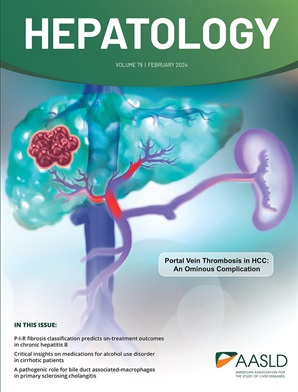Platelet-derived mitochondria regulate lipid metabolism in nonalcoholic steatohepatitis via extracellular vesicles
IF 12.9
1区 医学
Q1 GASTROENTEROLOGY & HEPATOLOGY
引用次数: 0
Abstract
Background & Aims: Immune system activation along with lipotoxicity due to excessive lipid droplet (LD) accumulation in the liver are key drivers of non-alcoholic steatohepatitis (NASH). Extracellular vesicles (EVs) released by cells that carry biological signals to contribute intercellular communication. But the roles of immune cells-derived EVs in pathogenesis of NASH are unclear. Approach & Results: Platelets are abundant in blood. We explored the role of platelet-derived EVs (pEVs) in LD accumulation from 30 patients with non-alcoholic fatty liver disease of different severity as well as 20 healthy subjects, a rat model, and an血小板衍生线粒体通过细胞外囊泡调节非酒精性脂肪性肝炎的脂质代谢
背景& 目的:免疫系统激活以及肝脏中脂滴(LD)过度积聚导致的脂肪毒性是非酒精性脂肪性肝炎(NASH)的主要诱因。细胞释放的胞外囊泡(EVs)携带生物信号,有助于细胞间的交流。但免疫细胞衍生的EVs在NASH发病机制中的作用尚不清楚。方法与结果:血小板在血液中含量丰富。我们从 30 例不同严重程度的非酒精性脂肪肝患者、20 例健康受试者、大鼠模型和基于体外细胞的试验中探讨了血小板衍生的 EVs(pEVs)在 LD 累积中的作用。在非酒精性脂肪肝患者/大鼠模型和棕榈酸酯处理的细胞中,血小板活化增加,并伴随着 pEVs 的释放。NASH 患者/大鼠血小板和 pEVs 中的线粒体数量增加,但功能失调,包括脂肪酸 β 氧化减少、ACC2 失活和氧化磷酸化系统复合体 II/III/IV 活性降低。这些受损线粒体可通过 pEV 转移到肝细胞中,从而增加脂滴结合线粒体(LDM)的数量。肝细胞中功能失调的 LDM 增加会影响脂质代谢,导致 LD 过度积累、线粒体 ROS 生成增加和细胞凋亡。结论:我们提供了一种新的分子机制,将血小板、pEVs 和 LD 过度累积与 NASH 的发展联系起来。我们的研究结果表明,通过特异性抑制 pEVs 的产生和释放,或通过靶向 pEVs 成分并抑制其吸收,可以缓解 NASH 的进展。要证实这种可能性,还需要更多的实验。
本文章由计算机程序翻译,如有差异,请以英文原文为准。
求助全文
约1分钟内获得全文
求助全文
来源期刊

Hepatology
医学-胃肠肝病学
CiteScore
27.50
自引率
3.70%
发文量
609
审稿时长
1 months
期刊介绍:
HEPATOLOGY is recognized as the leading publication in the field of liver disease. It features original, peer-reviewed articles covering various aspects of liver structure, function, and disease. The journal's distinguished Editorial Board carefully selects the best articles each month, focusing on topics including immunology, chronic hepatitis, viral hepatitis, cirrhosis, genetic and metabolic liver diseases, liver cancer, and drug metabolism.
 求助内容:
求助内容: 应助结果提醒方式:
应助结果提醒方式:


